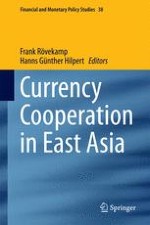2014 | OriginalPaper | Chapter
China’s Financial System: Past Reforms, Future Ambitions and Current State
Author : Patrick Hess
Published in: Currency Cooperation in East Asia
Publisher: Springer International Publishing
Activate our intelligent search to find suitable subject content or patents.
Select sections of text to find matching patents with Artificial Intelligence. powered by
Select sections of text to find additional relevant content using AI-assisted search. powered by
